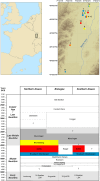Multi-isotope biographies and identities of victims of martial victory celebrations in Neolithic Europe
- PMID: 40834071
- PMCID: PMC12366695
- DOI: 10.1126/sciadv.adv3162
Multi-isotope biographies and identities of victims of martial victory celebrations in Neolithic Europe
Abstract
Skeletons showing multiple instances of unhealed trauma and isolated skeletal segments of severed left upper limbs have been documented in the Neolithic sites of Achenheim and Bergheim (northeastern France, approximately 4300 to 4150 cal BCE), providing tantalizing evidence of war-related practices of overkill, mutilation, and/or trophy taking. Here, we conduct an innovative multi-isotope reconstruction of the biographies of the "victims" and other individuals from the region that were given normative funerary treatments (nonvictims). A total of 82 humans are analyzed, together with 53 animals and 35 modern plants to establish regional isotope baselines. Results show statistically significant isotopic differences between victims and nonvictims and suggest that the former were members of invading groups brutally killed, perhaps exposed and deposited in pits-together with trophies in the form of severed upper limbs-by local groups in what might be one of the earliest well-documented instances of martial victory celebrations in prehistoric Europe.
Figures






Similar articles
-
Earliest evidence of sedentism in the Antilles: Multiple isotope data from Canímar Abajo, Cuba.Proc Natl Acad Sci U S A. 2025 Jan 7;122(1):e2413963121. doi: 10.1073/pnas.2413963121. Epub 2024 Dec 23. Proc Natl Acad Sci U S A. 2025. PMID: 39715435 Free PMC article.
-
Prescription of Controlled Substances: Benefits and Risks.2025 Jul 6. In: StatPearls [Internet]. Treasure Island (FL): StatPearls Publishing; 2025 Jan–. 2025 Jul 6. In: StatPearls [Internet]. Treasure Island (FL): StatPearls Publishing; 2025 Jan–. PMID: 30726003 Free Books & Documents.
-
Surveillance for Violent Deaths - National Violent Death Reporting System, 48 States, the District of Columbia, and Puerto Rico, 2020.MMWR Surveill Summ. 2023 May 26;72(5):1-38. doi: 10.15585/mmwr.ss7205a1. MMWR Surveill Summ. 2023. PMID: 37220104 Free PMC article.
-
Bone Type Selection for Human Molecular Genetic Identification of Skeletal Remains.Genes (Basel). 2025 Jul 24;16(8):872. doi: 10.3390/genes16080872. Genes (Basel). 2025. PMID: 40869920 Free PMC article. Review.
-
Fabricating mice and dementia: opening up relations in multi-species research.In: Jenkins N, Jack-Waugh A, Ritchie L, editors. Multi-Species Dementia Studies. Bristol (UK): Bristol University Press; 2025 Feb 25. Chapter 2. In: Jenkins N, Jack-Waugh A, Ritchie L, editors. Multi-Species Dementia Studies. Bristol (UK): Bristol University Press; 2025 Feb 25. Chapter 2. PMID: 40690569 Free Books & Documents. Review.
References
-
- C. Meyer, O. Kürbis, V. Dresely, K. W. Alt, “Patterns of collective violence in the early Neolithic of central Europe” in Prehistoric Warfare and Violence: Quantitative and Qualitative Approaches, A. Dolfini, R. J. Crellin, C. Horn, M. Uckelmann, Eds. (Springer, 2018), pp. 21–38.
-
- J. Orschiedt, C.-J. Kind, “Mesolithic human remains from Southern Germany” in Mesolithic burials – Rites, symbols and social organization of early postglacial communities, Proceedings of the International Conference, Halle (Saale), Germany, 18th-21st September 2013, J. Grünberg, B. Gramsch, L. Larsson, J. Orschiedt, H. Meller, Eds. (Tagungen des Landesmuseums für Vorgeschichte Halle 13/I1, 2016), pp. 373–383.
Publication types
MeSH terms
Substances
LinkOut - more resources
Full Text Sources

